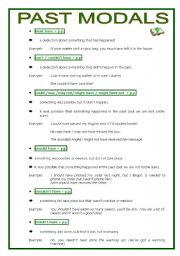
A woman phoned for you, but she didn’t give her name. Read the situations and use the words in brackets to write sentences with must have, may have and might have. “Who is that girl with Bob?” – “Ask Sheila. “Where’s Jack?” – “He _ be in his office”.ĭon’t make too much noise. Have you seen him?” – “He _ be in the canteen”.Ĥ. Police think the suspect may have left the country using a fake passport.ĭEDUCTIONS ABOUT PRESENT AND PAST ACTIONSĬomplete the sentences by putting in must, may or might.Į.g. Make sentences with the words given - T 21 Intermediate. Fill in the correct form - T26 Elementary. T034 - All tenses - multiple choice Intermediate. T035 - Present, Past and Present Perfect Tense Intermediate. I think I might have left the air conditioning on. T037 - All Tenses - Two Short Stories Elementary. We can use might have or may have + past participle when we think it’s possible that something happened. The door was locked and nothing was broken. Who told the newspapers about the prime minister’s plans? It must have been someone close to him. We use must have + past participle when we feel sure about what happened. The modal verb we choose shows how certain we are about the possibility. Past Continuous Tense Exercises, Past Perfect Exercises, Some Any Exercises, Future Tenses, Present Continuous Worksheet, Past Continuous Tense Exercise, Word Order.We can use modal verbs for deduction – guessing if something is true using the available information.

When To Use Did Not And Does Not? Did Doesn't Doesn't? Did Or Didn't Do? Did Not Go Or Did Not Went?do Does Did Don’T Doesn’T Didn’T, Do Does Did Don’T Doesn’T Didn’T Exercises, Do Does Did Don’T Doesn’T Didn’T Worksheets, Did Didn't Worksheet, Esl Did Didn't Worksheet, Past Continuous Exercises, Present Continuous Exercises, Possessive Adjectives Exercises

To Make A Question In The Past Tense In English We Normally Put The Auxiliary Did At The Beginning Of The Question Or Before The Main Subject. To Make A Question In The Simple Present Tense In English We Normally Put The Auxiliary Do Or Does At The Beginning Of The Question Before The Subject. We Sometimes Use The Verb Do To Replace A Verb When The Meaning Is Clear Or Obvious. Auxiliary Verb - Do - Don´t - Does - Doesn´t - Did. In Asking Questions: Do / Don't / Does / Doesn't Come Before The Subject. In Making Affirmatives Statements: Do / Don't / Does / Doesn't Comes After The Subject. The Words "do", "don't", "does" And "doesn't" Appear A Lot In English. Complete The Following Sentences By Using The Correct Form Of To Do Do, Don't, Does, Doesn't, Did, Didn't.


 0 kommentar(er)
0 kommentar(er)
